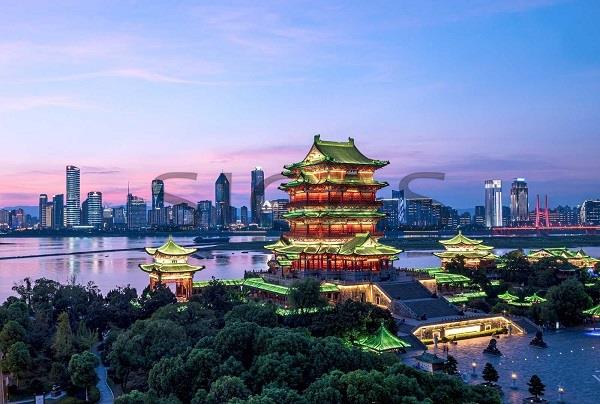Nanchang

Geography and Climate
Nanchang, means 'a prosperous south part of China', is the capital of Jiangxi Province and the center of the provincial economy, politics, science and technology, and culture and education, and is a 2,000 years old city with significant historical relevance. Situated to the southeast of Boyang Lake, Nanchang is a little north of the middle of Jiangxi Province. It is at 115° 37' E to 116° East Longitude and 28° 35' N to 28° 55' North Latitude. Its southeastern part is flat while northwestern part is characterized by undulation hills. There are six main districts in Nanchang and its urban area covers 7,402 kilometers. Nanchang has a population of 3,934,445 people and a metropolitan area consisting of 4,990,184 people. 37 ethnic groups were counted amongst its prefecture divisions. Moreover, Nanchang is famous for its scenic lakes, mountains, rich history and cultural sites.
Because of it location in subtropical zone, Nanchang has a monsoon-influenced humid subtropical climate with four distinct seasons. Winters are short and cool with occasional frosts; snow is not unheard of but heavy falls are otherwise rare. Summer is long and humid, with amongst the highest temperatures in China. Rain is greatest from March to June, and least in fall and early winter. Monthly averages in the city range from 5.3 °C (41.5 °F) in January to 29.2 °C (84.6 °F) in July, with an annual mean of 17.6 °C (63.7 °F).
History
Nanchang is a famous historical and cultural city with a history of over 2200 years. It has been enjoying the honor of “a given land abundant in natural resources and outstanding in producing talented figures”. Moreover, Nanchang is a heroic city with glorious revolutionary tradition. The People’s Liberation Army was born here and “the August 1st Spirit” appeared here. In addition, Nanchang is a scenic and environment-friendly city with beautiful mountains, rivers and lakes. The Gan River passes through the city from south to north and the whole city is dotted with rivers and lakes. At the outskirts of the city you can see green mountains.
Economy
Nanchang is a regional hub for agricultural production in Jiangxi Province. The yield of grain was 16.146 million tons in 2000. Products such as rice and oranges are economic staples. The Ford Motor Company has a plant in Nanchang, assembling the Ford Transit van as part of the Jiangling Motor joint venture. Nanchang also is a center of production for traditional Chinese medicine and pharmaceuticals.
The GDP of Nanchang in 2010 was 202 billion Yuan. The GDP per capita was over 6,000 USD. The city has developed into an industry system with all range. The major industries include automobile manufacturing, metallurgical industry, textile, chemical and pharmaceutical.
Landmarks
According to a survey, there are altogether 78 cultural sites with the Tengwang Pavilion as the most renowned. It was first built in 653 by Li Yuanying, a brother of Taizong Emperor of the Tang Dynasty (618-907). The famous essay in Chinese literature written by brilliant poet of the same period, Wang Bo, brought the pavilion ever great fame. It has been reputed as one of the four famous towers in China. The pavilion has been rebuilt or renovated for twenty-nine times and its twists and turns vividly show the changes of history.
Useful Link about Nanchang:
http://english.nc.gov.cn/











